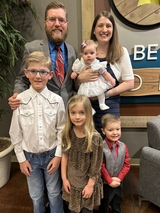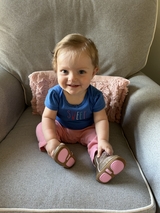A Chaotic Symphony: Managing Three Kids with HI
A Chaotic Symphony: Managing Three Kids with HI

Sometimes in Leah and Andrew’s home in rural Peyton, CO, it sounds like a symphony — a chaotic symphony. Son Jedidiah’s continuous glucose monitor (CGM) may be signaling a high blood sugar reading, daughter Hope’s insulin pump might be sending a low insulin sound, and baby Faith’s feeding tube pump could be chirping a reminder to put in a fresh bag of dextrose.
“It gets very musical at our house at times, when their monitors are all going off at once,” says Leah. The monitors for each child, set to different tones for high or low blood glucose or if the insulin or feeding pumps need a refill, are a critical part of how the family manages the children’s congenital hyperinsulinism (HI).
All three children have been cared for at the Congenital Hyperinsulinism Center at Children’s Hospital of Philadelphia (CHOP).
“CHOP is leading the way in treating HI,” Andrew says. “We’re so grateful for all they’ve done for our family.”
Why such low blood glucose?
The family’s journey into the world of HI began soon after Jedidiah was born. He was 6 weeks premature, and quickly whisked off to the NICU, where his low blood glucose (also called blood sugar) levels were recognized and treated with high volumes of dextrose (sugar water). It took doctors another week to suspect hyperinsulinism.
Jedidiah was transferred from his local hospital to a regional pediatric hospital, where surgeons performed first one, then a second, laparoscopic partial pancreatectomy in efforts to stabilize his glucose levels. It didn’t work, and by then, he had retained so much fluid that he needed a ventilatory oscillator to help him breathe.
“They were trying their best, but they weren’t familiar with HI,” Andrew says.
Rare disease requires expert care
Since HI is such a rare genetic disease, with 1 case in 25,000 to 50,000 births, many endocrinologists never see a case in their entire careers. In HI, the beta cells in the pancreas produce excess insulin, which drives down blood glucose to dangerously low levels. Extremely low blood glucose can trigger seizures, brain damage and even death.

Denver pediatric endocrinologist Clifford Bloch, MD, contacted CHOP, seeking help. “He was the voice advocating for Jedidiah to get to CHOP,” Andrew says. After 30 days in Colorado, Jedidiah and Leah flew by medical jet to Philadelphia.
When they landed and arrived at CHOP, Jedidiah’s glucose level was at 30 mg/dL — when normal levels are 70 to 100 mg/dL. “The nurses on the endocrine floor knew exactly what to do,” Leah says. “Because of the fluid overload, they got him stabilized on a glucagon drip.”
David Langdon, MD, then the HI Center’s inpatient endocrinologist who has since retired, became the family’s guide to all things HI. “He did an amazing job explaining everything to us,” Leah says. “Dr. Langdon was an incredible listener as we talked through our concerns and fears. He really wanted to hear our opinion.”
The HI team, along with Leah and Andrew, decided that Jedidiah needed even more of his pancreas removed to be able to manage his HI. Surgeon-in-Chief N. Scott Adzick, MD, MMM, who has performed more than 640 pancreatomies at CHOP, did the surgery, taking out almost all of the remaining head of the pancreas.
Straight to diabetes
The difference in his blood sugar was dramatic. In fact, Jedidiah bypassed the stage most near-total pancreatectomy patients experience where they still need medication or dextrose to keep their glucose levels well managed. Instead, he immediately developed insulin-requiring diabetes, which has been manageable.
During their remaining time at CHOP, his parents were thoroughly educated in how to manage diabetes and coached through handling his day-to-day care. “Leaving CHOP could have been one of the most terrifying moments for us,” Leah says. “I was feeling overwhelmed, but CHOP did a great job preparing us for how to take care of him.”
Preparing for baby No. 2

Four years later, when Leah was pregnant with her daughter Hope, the family — and their local hospital — was prepared for the possibility that Hope could also have HI. There was a 1-in-4 chance she would have inherited the recessive ABCC8 mutation that each parent carries and therefore have it.
“We decided to wait until she was born to find out,” Leah says, “The hospital was ready with the sibling protocol from CHOP, so she could be monitored as soon as she was born and kept safe.”
The prep paid off. Hope’s blood sugar was less than 20 mg/dL at birth, so she was immediately started on intravenous dextrose, per the CHOP protocol. Her blood for genetic testing was taken and sent off, and in two weeks Hope was at CHOP awaiting her near-total pancreatectomy by Dr. Adzick. Hope came home from CHOP on insulin, and several months later had a short time without requiring any insulin. She went back to needing insulin and has had diabetes ever since.
“This time, I felt very confident bringing her home,” Leah says.
In 2020, a third baby, Ezekiel, was born. His test for low glucose came back normal, even after having a safety fast. He was declared HI-free, although his genetic test showed he was a carrier.
Fourth birth, third child with HI
Leah was pregnant again in fall 2023, and this time around, she was induced at 39 weeks. Still, little Faith wasn’t so little, weighing in at 10 pounds, 3 ounces. “As soon as I heard the weight, I thought, ‘Uh oh, here we go again,’” Leah says, as she was aware HI babies are known for being big at birth. Indeed, Faith’s initial blood glucose reading was in the 20s, and she was started on IV dextrose right away.

Wasting no time, the local hospital and the family immediately contacted CHOP and Faith and Leah were in Philadelphia a week later. “We were even able to schedule her surgery before we left Colorado,” Andrew says.
The family was hoping for a short stay in Philly because Andrew was staying home with Jedidiah, Hope and Ezekiel. “It was very difficult being separated as a family,” Leah says. “We told them we wanted to be home for Ezekiel’s third birthday, and even though it was an aggressive timeline, they were willing to work with us. We made it by a day.”
A few days after Dr. Adzick performed Faith’s near-total pancreatectomy — “We joked with him that we should get the ‘buy two, get one free’ special,” Leah says — Faith’s blood glucose went low, which is common when the remaining bit of pancreatic beta cells are releasing excess insulin. She was started on continuous dextrose via a g-tube and, after discharge, began taking octreotide to manage the lows.
“They initially wanted us to come back to CHOP to trial the octreotide, but we didn’t want to be separated from the family again,” Leah says. “So, Dr. Katherine Lord worked with our local endocrinologist to start the protocol. It really impressed us that the HI Center valued our needs and still found a way for Faith to get the care she needed.”
“And we’re grateful our local endocrinologist was willing to work with CHOP, since that’s where the HI experts are,” Andrew says.
What next? Contribute to research
“One thing we think about is how HI will impact our grandchildren and great-grandchildren,” Leah says. “It is going to be part of our family line.”
That is one reason the family decided to donate the children’s removed pancreatic tissue to the research lab of Diva D. De León-Crutchlow, MD, MSCE, Chief of the Division of Endocrinology and Diabetes and Director of the HI Center.
“She is trying to cure HI at the cellular level,” Leah says. “We’re not sure if that cure will be here for our grandkids, but we wanted to contribute to her work in any way we could.”